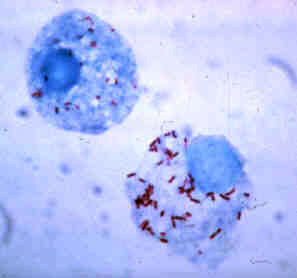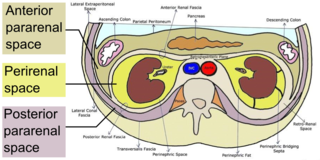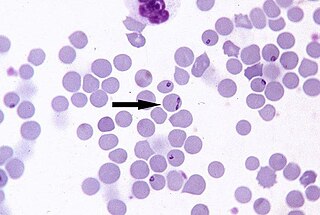Related Research Articles

Rickettsia is a genus of nonmotile, gram-negative, nonspore-forming, highly pleomorphic bacteria that may occur in the forms of cocci, bacilli, or threads. The genus was named after Howard Taylor Ricketts in honor of his pioneering work on tick-borne spotted fever.

The retroperitoneal space (retroperitoneum) is the anatomical space behind (retro) the peritoneum. It has no specific delineating anatomical structures. Organs are retroperitoneal if they have peritoneum on their anterior side only. Structures that are not suspended by mesentery in the abdominal cavity and that lie between the parietal peritoneum and abdominal wall are classified as retroperitoneal.

Rickettsia rickettsii is a Gram-negative, intracellular, coccobacillus bacterium that was first discovered in 1902. Having a reduced genome, the bacterium harvests nutrients from its host cell to carry out respiration, making it an organoheterotroph. Maintenance of its genome is carried out through vertical gene transfer where specialization of the bacterium allows it to shuttle host sugars directly into its TCA cycle.
Tick-borne diseases, which afflict humans and other animals, are caused by infectious agents transmitted by tick bites. They are caused by infection with a variety of pathogens, including rickettsia and other types of bacteria, viruses, and protozoa. The economic impact of tick-borne diseases is considered to be substantial in humans, and tick-borne diseases are estimated to affect ~80 % of cattle worldwide. Most of these pathogens require passage through vertebrate hosts as part of their life cycle. Tick-borne infections in humans, farm animals, and companion animals are primarily associated with wildlife animal reservoirs. Many tick-borne infections in humans involve a complex cycle between wildlife animal reservoirs and tick vectors. The survival and transmission of these tick-borne viruses are closely linked to their interactions with tick vectors and host cells. These viruses are classified into different families, including Asfarviridae, Reoviridae, Rhabdoviridae, Orthomyxoviridae, Bunyaviridae, and Flaviviridae.

In human anatomy, the left gastric artery arises from the celiac artery and runs along the superior portion of the lesser curvature of the stomach before anastomosing with the right gastric artery. It also issues esophageal branches that supply lower esophagus and ascend through the esophageal hiatus to form anastomoses with the esophageal branches of thoracic part of aorta.

Citrobacter is a genus of Gram-negative, aerobic, rod-shaped coliform bacteria of the Enterobacteriaceae family.

Monobactams are bacterially-produced monocyclic β-lactam antibiotics. The β-lactam ring is not fused to another ring, in contrast to most other β-lactams.

The membranous urethra or intermediate part of male urethra is the shortest, least dilatable, and, with the exception of the urinary meatus, the narrowest part of the urethra. It extends from the apex of the prostate proximally to the bulb of urethra distally. It measures some 12 mm in length. It traverses the pelvic floor. It is surrounded by the external urethral sphincter, which is in turn envelopped by the superior fascia of the urogenital diaphragm.

Babesia divergens is an intraerythrocytic parasite, transmitted by the tick Ixodes ricinus. It is the most common cause of human babesiosis. It is the main agent of bovine babesiosis, or "redwater fever", in Europe. Young cattle are less susceptible. The current emphasis in Europe on sustainable agriculture and extensification is likely to lead to an increase in vector tick populations with increased risk of infection. B. divergens is also prevalent in cottontail rabbits on Nantucket Island, MA, USA.

Borrelia hermsii is a spirochete bacterium representing the endemic causative agent of tick-borne relapsing fever in eastern regions of North America. It is spread by the soft-bodied tick Ornithodoros hermsi. Human infections characteristically occur among campers and people temporarily lodging in wooden accommodations in proximity to rodents. Human disease is usually relatively mild with low fever.

African tick bite fever (ATBF) is a bacterial infection spread by the bite of a tick. Symptoms may include fever, headache, muscle pain, and a rash. At the site of the bite there is typically a red skin sore with a dark center. The onset of symptoms usually occurs 4–10 days after the bite. Complications are rare but may include joint inflammation. Some people do not develop symptoms.
Queensland tick typhus is a zoonotic disease caused by the bacterium Rickettsia australis. It is transmitted by the ticks Ixodes holocyclus and Ixodes tasmani.
Rickettsia australis is a bacterium that causes a medical condition called Queensland tick typhus. The probable vectors are the tick species, Ixodes holocyclus and Ixodes tasmani. Small marsupials are suspected reservoirs of this bacterium.
Borrelia afzelii is a species of Borrelia endemic to parts of Eurasia where it is one of the causative agents of Lyme disease. It is transmitted by hard-bodied ticks of the Ixodes genus, infecting various wild mammals in nature.

Rickettsia parkeri is a gram-negative intracellular bacterium. The organism is found in the Western Hemisphere and is transmitted via the bite of hard ticks of the genus Amblyomma. R. parkeri causes mild spotted fever disease in humans, whose most common signs and symptoms are fever, an eschar at the site of tick attachment, rash, headache, and muscle aches. Doxycycline is the most common drug used to reduce the symptoms associated with disease.
Rickettsia helvetica, previously known as the Swiss agent, is a bacterium found in Dermacentor reticulatus and other ticks, which has been implicated as a suspected but unconfirmed human pathogen. First recognized in 1979 in Ixodes ricinus ticks in Switzerland as a new member of the spotted fever group of Rickettsia, the R. helvetica bacterium was eventually isolated in 1993. Although R. helvetica was initially thought to be harmless in humans and many animal species, some individual case reports suggest that it may be capable of causing a nonspecific fever in humans. In 1997, a man living in eastern France seroconverted to Rickettsia 4 weeks after onset of an unexplained febrile illness. In 2010, a case report indicated that tick-borne R. helvetica can also cause meningitis in humans.
Borrelia duttoni is a species of Borrelia. It is the endemic causative agent of tick-borne relapsing fever in parts of sub-Saharan Africa, and Madagascar. It is transmitted by the soft-bodied tick Ornithodoros moubata which sheds the pathogen in its saliva and coxal fluid. Vertical transmission occurs in ticks which thus appear to represent the major reservoir of this pathogen. Humans appear to be the sole vertebrate host of B. duttoni. Human disease is characterised by a long incubation period, numerous brief recurrences, and frequent ocular involvement. Infection results immunity which is enduring but strain-specific.

Ornithodoros moubata, commonly known as the African hut tampan or the eyeless tampan, is a species of tick in the family Argasidae. It is an ectoparasite and vector of relapsing fever in humans, and African swine fever in pigs.
Borrelia garinii is a species of spirochete bacterium in the genus Borrelia. It is endemic to parts of Eurasia where it is one of the causative organisms of human Lyme disease. It is transmitted by hard-bodied ticks of the Ixodes genus, infecting various wild woodland mammals.
Circulus arteriosus minor or minor arterial circle of iris is an arterial circle near the pupillary margin of the iris. It is formed by branches from the major arterial circle of the iris.
References
- 1 2 "lymphadénopathie à tiques - Dictionnaire médical de l'Académie de Médecine". www.academie-medecine.fr. Retrieved 2024-02-06.
- 1 2 "Rickettsia slovaca - Dictionnaire médical de l'Académie de Médecine". www.academie-medecine.fr. Retrieved 2024-02-06.